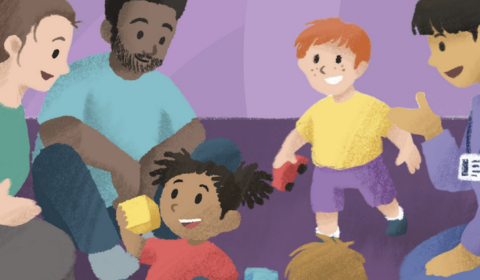Race-reimaging in educational psychology

As individuals from minority ethnic backgrounds, we, Anita and Preeya, have spent time during supervision thinking about issues of representation.
Why we got here
Our supervisor-supervisee relationship is an open and accepting one, where we can discuss our thoughts and reflections from working in a field in which we don’t look like the majority of our colleagues. Anita signposted Preeya to a BPS PsychCrunch podcast episode titled “Whose psychology is it anyway? Making psychological research more representative”. The episode highlighted the lack of diversity in top-tier psychology journals and how this can influence our assumptions about participants of different racial identities.
This prompted Preeya to look specifically at diversity of research in the field of educational psychology. She found a seminal paper by DeCuir-Gunby and Schutz (2014) in which the authors proposed two additional approaches to more effectively explore racial issues in education and increase the representation of minority groups in research. Here, we focus on their concept of race-reimaging and its relevance to our work.
What is race-reimaging?
DeCuir-Gunby and Schutz (2014) define race-reimaging as reconceptualising traditional constructs in educational psychology, such as self-regulation, to look at them through a socioculturally relevant lens. This approach takes into account history, context and the intersectionality of identities – including race and culture. In this way, we can view a psychological construct from the perspective of the specific cultural group we are studying or working with, incorporating their values to reimage what the construct means for them.
We have developed our understanding of race-reimaging by thinking about it in relation to other, more familiar, concepts. It links to strengths-based approaches as it promotes a shift away from a deficit model in which racial groups are compared, and White people are often concluded to be the dominant group.
In terms of the rich and detailed understanding we can gain from race-reimaging, we reflected on how Interpretive Phenomenological Analysis shares similar principles. It is important to clearly explain our own values and reflections in both research and case formulations, and distinguish these from the sociocultural values of the people we are studying or working with. Critical race theory is one methodology DeCuir-Gunby and Schutz proposed to enable us to centralise the concept of race and take into account individual experiences and interpretations.
Examples of race-reimaging
Following discussions about representation in psychological research, we reflected on examples of race-reimaging and how we can apply the concept to our daily practice.
Playing in the sand
Anita shared two examples from her personal and professional experiences within early childhood. The first relates to play – something that is often taken for granted. Play can, as with many things, be viewed through a romantic discourse of childhood and indeed a White, Eurocentric lens. We discussed how sand play is constructed, and seen within nurseries and Reception classes as a standard aspect of play, both indoors and outdoors. It allows children to learn about key concepts such as ‘empty’ and ‘full’, engage in pretend play and generally have fun without getting too dirty!
However, in talking it over with Preeya, we discussed the word used for sand by my Mum, namely ‘miti’. This is the same word I heard other South Asian parents using when I was a Reception class teacher. This is not a direct translation of ‘sand’, according to Google Translate; indeed it means ‘soil’. However, to me as a child it meant ‘dirt’. This carried negative connotations for me that sand play was not appropriate play, as I would get dirty and that was not something you should do when you were at school.
Outdoor play
More recently, I was led to reflect on outdoor early childhood provision. I met with a father to talk to him about his son’s attendance at nursery. He explained to me that he had not liked a previous nursery’s provision, as the babies were left to sleep in prams outside. This is a common practice in some parts of the world, particularly some nurseries in Nordic countries such as Sweden, and I was aware this nursery was interested in adopting such approaches.
I listened as this caring Bengali father highlighted his concern that the nursery may not have enough staff or space to support the children inside, and the implications of this. He explained that he thought this practice would lead to babies becoming unwell, or being bitten by insects, and led to him feel that the nursery could not care for his son. This perspective seemingly sprang from concerns that might be relevant in his home country, but not necessarily in Western Europe.
Conclusion
Preeya and I discussed that these two relatively simple examples could be race re-imaged. This meant looking at the traditional constructs, in these instances early childhood sand play and outdoor provision, and examining them through a socioculturally relevant lens.
It helped us to foreground the care and love of the parents for their children, rather than focus on their unwillingness to engage in what may be seen as traditional early childhood practices and approaches. This enabled us to take account of culture, history and context to reimage key constructs in our work.
References
DeCuir-Gunby, J. T., & Schutz, P. A. (2014). Researching race within educational psychology contexts. Educational Psychologist, 49(4), 244-260.





I hadn’t been aware of the different vocabularies involved [although a long time ago I discovered that Russian does not have a word for ‘home’] and this is highly relevant. Could some of this be overcome by a] increasing awareness among nursery staff etc and b] being able to offer a lot more time to new parents, explaining what is being done and why? Years ago I remember running courses to explain many of the activities in Nursery – playing with scissors, pouring etc – why we were doing it and how parents could support this at home.
Out of curiosity, do Nurseries in S Asia offer sand play? and how do they refer to it?